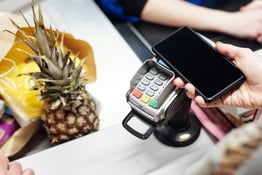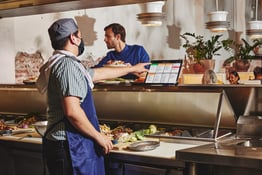As restaurant operator D'Andre Carter grew his business, he knew having a digital communication platform would be critical to its success. Carter, who runs the popular, Chicago-based barbecue concept Soul & Smoke, adopted Slack back in 2020, and his team now relies on the platform daily to relay important information between three restaurant locations.
“It allows our management team greater visibility into what’s happening at all of our locations at any given time,” says Carter. “When a store has an issue they need help with, they can tag multiple people in their message to ensure the issue is resolved quickly…and we have so many Slack channels – channels related to attendance and payroll, store specific channels related to orders and reporting, office channels for administrative tasks, etcetera.”
Slack is just one among a number of digital communication tools that restaurant operators use across the industry. It’s most notably known for its ability to allow teams to create project- and topic-based channels where people relevant to the conversation can join and share ideas, updates, and other information. Many restaurant scheduling software also have built-in tools that offer similar features, allowing restaurants to streamline communications and create private and group chats. These chat and channel features enable staff to organize discussions across a wide range of topics, and keep conversations accessible from one centralized platform.
“Having a place and a tool to communicate – in everyone’s pocket on their phone for staff to access outside of the restaurant – is really critical,” says Brent Beatty, vice president of product at 7shifts, a restaurant employee scheduling software with its own built-in communication platform. “It saves time for managers so that they don’t have to find emails and phone numbers and can communicate to people en masse, and it also helps retain employees. Good communication is important for creating a positive and healthy work environment – frustrations from employees often come from lack of access to information.”
Communication is at the core of any successful business. Making it easy for staff to stay on top of what’s happening at the restaurant, and also build connections with other employees, will help facilitate stronger connections between staff and the workplace. We break down how adopting a mobile communication platform can enhance restaurant-wide communications and some of the top ways restaurants are using current platforms.
How will a digital communications platform benefit my restaurant over traditional methods, like phone or email?
Work-life balance: Very few people want to add another group text message to their life, especially one that’s sending them alerts at all hours of the day about their work. Mobile communication platforms allow restaurants to facilitate and consolidate multiple conversations, but also create work-life balance by allowing employees to turn off notifications at the end of the day. There are options to get a mobile alert every time a new message is received, but there are also options to only be notified once you open the actual app. Many platforms also allow you to opt into push notifications for high priority group chats, while silencing notifications for others. Traditional communication methods simply don’t offer the same flexibility and organization.
Security and socialization: Platforms like Slack are also highly secure, and they minimize the need to share personal contact details or track down someone’s phone number to swap a shift, for example.
“It really helps with engaging employees, and we know employees are socializing and finding ways to chat, so why not ways to formalize it and put some structure around it,” says Duane Peck, Slack’s head of industry marketing, slack retail, and consumer goods.
Organization: Most communication platforms also offer search features so that you don’t have to sort through multiple text and email threads to try and find an old conversation. “We have a farm-to-table restaurant, SingleThread, on Slack that’s often updating their menus, so they have an ingredient planning channel, and once the month is over, they can archive it but also refer back to it in the next year,” says Peck, sharing just one use case of how Slack enhances operational organization.
With scheduling software that offers built-in communication tools, there are additional organizational advantages as well, especially when it comes to scheduling.
“All of the information you’ve collected about employees – the roles and locations where they work, time punches, information around tasks and shift trades, and also the schedules posted – all gets centered in one place,” says Beatty. “Managers and staff don’t have to jump around from text to email to chat app to get the information.”
How do restaurants typically use communication platforms in day-to-day operations?
There are countless ways that group channels and one-on-one chats can help organize your business, from streamlining catering communication to sharing employee praise to announcing company wide updates to centralizing new recipe and menu ideation.
“We have a [Slack] channel for all aspects of the business, be that customer feedback, food, catering, delivery, partners, brand-promotions, accounting, retail, operations, or leadership,” says Florian Pfahler, founder of sandwich concept Hannah's Bretzel. “It’s the most efficient way to communicate with a specific individual or the entire team and bring new items and issues to their immediate awareness. We also have dedicated groups by team members for items of a more personal or confidential nature, which have allowed team members to communicate on more sensitive topics.”
Scheduling software When I Work says its restaurant clients use its chat features most often to discuss factors related to scheduling. “Managers will use team messaging to communicate in greater detail about upcoming shifts or the schedule that’s been posted, or about events that are coming up and the important details,” says When I Work founder Chad Halvorson. “It’s also heavily utilized by staff to get input on who might be available for an extra shift or interested in working extra hours.”
With many platforms, there are options to upload videos and photos alongside text. Slack says its users often use the platform to post short training videos that then become a reference employees can look back on across time. “Let’s say you’re onboarding a new waiter and you have certain policies in place about table setup,” says Peck. “You could easily record a video clip to post, and that way you can actually show, ‘This is what good looks like when we’re closing the restaurant at night.’”
Peck notes restaurants also often create “repair request” channels on Slack. Anytime an employee sees an appliance or something broken, they can post a picture in the channel and tag the manager. “This allows the manager to reply and maybe even tag someone else to ask them to stop by Home Depot on the way to work,” says Peck.
How much do mobile communication platforms cost?
Good news: A communication platform is likely to be among the most affordable part of your restaurant’s tech stack. Those attached to scheduling software, like 7shifts and When I Work, are often included in the general subscription price.
Slack offers a free subscription option. However, to make the most of the app, consider upgrading to one of Slack’s higher level subscriptions, which run from $7.25 to $12.50 per month and enable you to save your conversation history indefinitely. It’s an investment that Pfahler says has been well worth it.
“We use Slack for all internal communication that does not require a lot of data or information, which is 90% of the time,” says Pfahler. “The ability to form groups enables us to bring our fragmented company together in a virtual, central communication marketplace, something we deeply struggled with prior to the arrival of Slack.”





